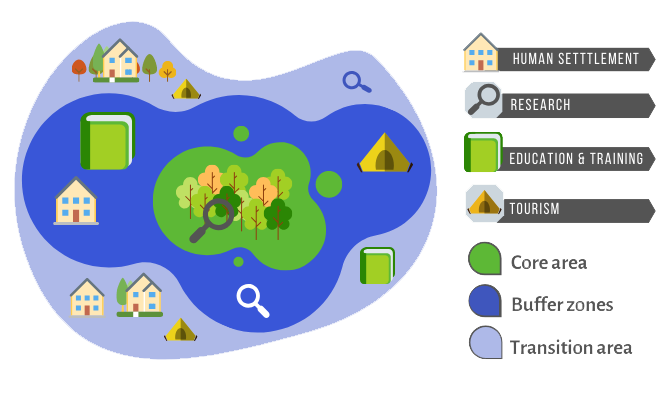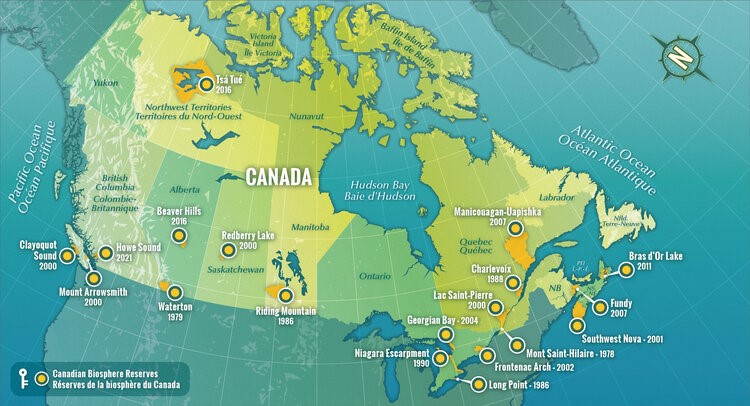Biosphere reserves in Canada
Backgrounder
Biosphere reserves are sites recognized by UNESCO’s Man and the Biosphere Programme and are models of a sustainable future that protect and celebrate cultural and biological diversity, and that empower people to engage with one another and with nature in healthier ways. Biosphere reserves in Canada are designated areas where communities are actively working to conserve biodiversity and implement the UN Sustainable Development Goals supported by Canada.
Zones
Biosphere reserves have three distinct zones:

Credit: UNESCO
- a core protected area, consisting of a strictly protected ecosystem (e.g. national wildlife area, migratory bird sanctuary, or national park) that contributes to the conservation of landscapes, ecosystems, species, and genetic variation;
- a buffer zone, used for limited activities, compatible with sound ecological practices that can reinforce scientific research, monitoring, training, and education; and
- a transition area, where greater activity is allowed, fostering socio-culturally and ecologically sustainable economic and human development.
Biosphere reserves in Canada
There are nineteen biosphere reserves across Canada. They reflect the geographic diversity of Canada and some of its most iconic landscapes, and bring people together at a regional level in support of domestic and international environmental and sustainable development goals and principles.
Biosphere reserves are located in areas with high conservation value and potential; all but one are located in southern Canada. There is a biosphere reserve in Northwest Territories and there is at least one in every province, with the exception of Newfoundland and Labrador and Prince Edward Island.

Credit: Canadian Biosphere Reserves Association
From east to west:
- Bras d’Or Lake, NS
- Southwest Nova, NS
- Fundy, NB
- Manicouagan-Uapishka, QC
- Charlevoix, QC
- Lac Saint-Pierre, QC
- Mont Saint-Hilaire, QC
- Frontenac Arch, ON
- Georgian Bay / Mnidoo Gamii, ON
- Long Point, ON
- Niagara Escarpment, ON
- Riding Mountain, MB
- Redberry Lake, SK
- Beaver Hills, AB
- Waterton, AB
- Tsá Tué, NWT
- Átl'ka7tsem / Howe Sound, BC
- Mount Arrowsmith, BC
- Clayoquot Sound, BC
Example: Manicouagan-Uapishka Biosphere Reserve
The Manicouagan-Uapishka Biosphere Reserve in the Baie-Comeau region of Quebec was first recognized in 2007. It came together through collaboration and partnership with the Regional Tourism Association (ATR) of Manicouagan (now Tourisme Côte-Nord), the Regional County Municipality (MRC) of Manicouagan, the Council of the Innu of Pessamit, the City of Baie-Comeau, Hydro-Québec, and the Kruger Company.
It is located east of Québec City, on the north shore of the St. Lawrence, and covers 5.5 million hectares, making it the second largest biosphere reserve in Canada. The landscapes are diverse and include steep cliffs on the water’s edge, vast tracts of boreal forest, and the Uapishka mountains to the north. The salt marshes of the Manicouagan-Uapishka reserve are among the most productive habitats on the planet, acting as important resting places for more than 200 migratory birds. It is also home to many species at risk, including woodland caribou.
Project examples
To achieve its mission, the Manicouagan-Uapishka Biosphere Reserve founded three business units: MU Conseils, a participatory strategy consulting firm; the Uapishka Station, a scientific research and ecotourism facility; and a project development component for environmental and human-based research, education, and continuous monitoring. These business units complement each other and sustain themselves in carrying out the functions of a biosphere reserve.
- Ma Ville, Ma Voix: annual community-driven consultation and engagement process for sustainable development projects in Baie-Comeau.
- Co-developing and implementing a minimum Monitoring and Research Program with the Innu Community of Pessamit and research partners: UQAR (University of Quebec at Rimouski) and INQ (Institut nordique du Québec).
- Working with the Pessamit Innu Guardians to enforce the new snowmobiling rules and protect their traditional territory.
- Managing ecotourism and consultation activities within a protected area with the Government of Quebec and community stakeholders, such as the Innu community of Pessamit, and the snowmobiling and hiking communities. This is helping to protect wildlife, like caribou, and their habitat.
- Supporting and enabling research: the Canadian Forest Service has undertaken a four-year research project to study woodland caribou habitat and food sources.